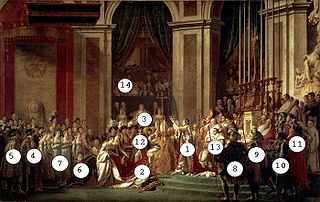Le Sacre de Napoléon

|
| Le Sacre de Napoléon |
|---|
| Jacques-Louis David , 1805–1807 (issued 1808) |
| Oil on canvas |
| 621 × 979 cm |
| Louvre , Paris , France |
Le Sacre de Napoléon is a well-known painting, which was completed in 1807 by Jacques-Louis David , the official painter of Napoleon , and depicts the imperial coronation of Napoleon I in the Notre-Dame de Paris cathedral . The picture has monumental dimensions of almost 10 m × 6 m.
History of the work
The painting was commissioned by Napoleon in September 1804 and has the official title Sacre de l'empereur Napoléon I er et couronnement de l'impératrice Joséphine dans la cathédrale Notre-Dame de Paris, le 2 December 1804 . Jacques-Louis David began work on December 21, 1805 in the former chapel of the College of Cluny near the Sorbonne , which he used as a workshop. He was supported by his student Georges Rouget, who put the finishing touches on the work in January 1808. From February 7th to March 21st, 1808 it was exhibited at the Salon de Paris . In 1810 it was awarded at the Prix Décennaux. It remained the property of David until 1819 before it was given to the Musées Royaux. It was stored there until 1837 and then exhibited at the request of King Louis-Philippe in the musée historique du château de Versailles in the Salle du Sacre. In 1889 it was exhibited in the Louvre , and its place was taken by a full-size replica commissioned by a group of American businessmen from David in 1807, begun in 1808 and completed in 1822 in exile in Belgium.
composition
The composition has several axes and adheres to the rules of neoclassicism . An axis goes through the vertical cross. All eyes are on Napoleon, at the center of the composition.
characters
- Napoleon I (1769–1821) is standing and dressed in a coronation robe similar to that of the Roman emperors.
- Joséphine de Beauharnais (1763–1814) kneels in a submissive position as required by the Civil Code . She receives the crown from her husband's hands and not from the Pope.
- Maria Letizia Ramolino (1750–1836), Napoleon's mother, was placed by the painter's stalls. Your place is more important than that of the Pope. In reality, she was not present at the ceremony to protest Napoleon's quarrels with his brothers Lucien and Joseph. Napoleon's father died in 1785. Maria Letizia asked the painter to give her an honorable place in the painting.
- Louis Bonaparte (1778–1846), who received the title of Grand Constable and King of Holland at the beginning of the Empire in 1806. He married Hortense de Beauharnais , Josephine's daughter.
- Joseph Bonaparte (1768–1844) was not invited and did not take part because of a quarrel with Napoleon. After the coronation, he received the title of Imperial Prince. In 1806 he was made King of Naples and in 1808 of Spain.
- The young Napoleon Charles Bonaparte (1802–1807), son of Louis Bonaparte and Hortense de Beauharnais .
- The sisters of Napoleon. In the replica, the dress of the favorite sister is pink. This is the only change to the replica, despite being repainted from memory.
- Charles-François Lebrun (1739–1824), the third consul alongside Napoleon and Jean-Jacques Régis de Cambacérès . During the First Empire , he took the place of Prince-architrésorier. He holds the scepter .
- Jean-Jacques Régis de Cambacérès (1753-1824), Arch-Chancellor prince of the Empire. He holds the scepter main de justice.
- Louis-Alexandre Berthier (1753–1815), Minister of War during the consulate . Marshal Empire in 1805. He is holding an orb .
- Talleyrand (1754–1838), Grand Duke since July 11, 1804.
- Joachim Murat (1767–1815), Marshal of the Empire, King of Naples after 1808, brother-in-law of Napoleon and husband of Caroline Bonaparte .
- Pope Pius VII (1742–1823) was content to bless the coronation. He is surrounded by clerical dignitaries appointed by Napoleon since the Concordat.
- The painter Jacques-Louis David depicted himself in the stands.
- Halet Efendi , the envoy of the Ottoman Sultan Selim III.
- Dom Raphaël de Monachis, Greek-Egyptian monk and member of the Institut d'Égypte, stands to the right of the bishop with a red hood and beard.
Individual evidence
- ^ Philippe Bordes: Jacques-Louis David: Empire to Exile . Yale University Press, January 2007, ISBN 0-300-12346-9 , pp. IX, 28, 293, 297, 333.
swell
- Sylvain Laveissière, Le Sacre de Napoléon peint par David , Paris, Musée du Louvre, 2004
- Jean Tulard , Le Sacre de l'empereur Napoléon. Histoire et légende , Paris 2004 2-213-62098-9

